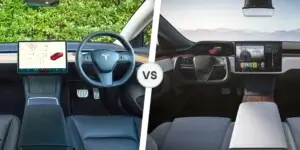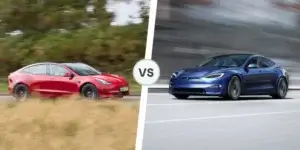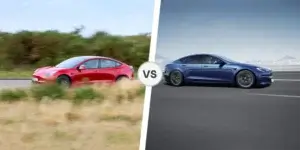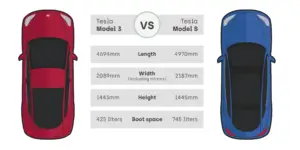What are the differences in size and styling between the Tesla Model 3 and Model S?
The Tesla Model 3 is a mid-size saloon, comparable in size to the BMW 3 Series, while the Tesla Model S is a large hatchback, similar in size to the BMW 5 Series. The Model S is nearly 28cm longer and slightly wider and taller than the Model 3. Both cars share a sleek, aerodynamic design aimed at maximising battery range, although there are notable differences, particularly at the front of the cars.
The Model 3 features horizontal headlights, whereas the Model S, the only Tesla with a front grille, has a slim grille on newer models and a larger one on pre-2016 cars.
How do the interiors and tech compare in the Tesla Model 3 and Model S?
All Tesla models feature a minimalistic interior dominated by a large touchscreen. In the Model 3, this vertical screen is the sole display, controlling everything from the speedometer to the sunroof. The Model S, however, includes an additional driver’s display behind the steering wheel and more conventional controls on older models. While it may take some time to get used to controlling most functions via a touchscreen, once acclimated, the system is intuitive and easy to use.

What equipment comes standard with the Tesla Model 3 and Model S?
Both the Model 3 and Model S come well-equipped, featuring sat nav, Bluetooth, climate control, adaptive cruise control, wireless charging pads, electrically adjustable heated front seats, leather upholstery, and a panoramic glass roof as standard. Tesla has frequently updated the trim levels, often focusing on battery performance and wheel designs.
How does boot space and practicality differ between the Tesla Model 3 and Model S?
Both the Model 3 and Model S offer ample space for passengers and cargo, thanks to their electric design, which places the batteries under the floor and eliminates the need for a large engine compartment. The Model S, being larger, offers more boot space and versatility with its hatchback design. Some older Model S models even feature extra rear-facing seats in the boot, suitable for children under 13 according to UK law. The Model 3’s boot is smaller but still adequate for most families.
Both models also feature a ‘frunk’—a front trunk where the engine would typically be, providing extra storage space.

How does the driving experience compare between the Tesla Model 3 and Model S?
Tesla cars are renowned for their quick acceleration, with the Model S Plaid accelerating from 0 to 62mph in just two seconds, faster than many supercars. Even the less extreme versions of the Model 3 and Model S can reach 62mph in under six seconds. Both models feature light steering and nimble handling, offering a smooth and quiet ride. The Model 3’s smaller size makes it feel more responsive on the road and easier to manoeuvre in tight spaces.
What is the range of the Tesla Model 3 and Model S?
The range of both models depends on the age and specification of the individual car. Generally, the Model 3 offers a range of 237 to 382 miles, while the Model S ranges from 248 to 405 miles. Real-world mileage may vary, but both models provide excellent ranges compared to many other electric cars. Tesla’s Supercharger network further enhances their appeal for long journeys, offering fast charging at numerous locations across the UK.

How safe and reliable are the Tesla Model 3 and Model S?
Both the Model 3 and Model S have earned top safety ratings from Euro NCAP, with the Model 3 achieving the highest scores of any car tested in 2018. Both models come with advanced driver assistance features like automatic emergency braking, lane-departure warning, lane-keeping assistance, and speed limiters. While some have questioned Tesla’s build quality compared to other premium brands, many owners report no significant issues, and software updates can often resolve minor problems.

Dimensions of the Tesla Model 3 vs Tesla Model S
Tesla Model 3
- Length: 4694mm
- Width: 2089mm (including door mirrors)
- Height: 1443mm
- Boot space: 425 litres
Tesla Model S
- Length: 4970mm
- Width: 2187mm (including door mirrors)
- Height: 1445mm
- Boot space: 745 litres

Verdict
Both the Tesla Model 3 and Model S are excellent choices, offering space, advanced technology, and impressive battery range. The Model S is the better option if you need more space, but the Model 3 is more convenient in size, cost-effective, and boasts a modern, high-tech look.
For more information on buying used cars, including safe buying advice, check out our buyer’s guide and explore our guides on car maintenance and electric vehicles.
Ready to make your choice? Explore our used Tesla Model 3 and used Tesla Model S listings and take the next step towards owning a Tesla.


